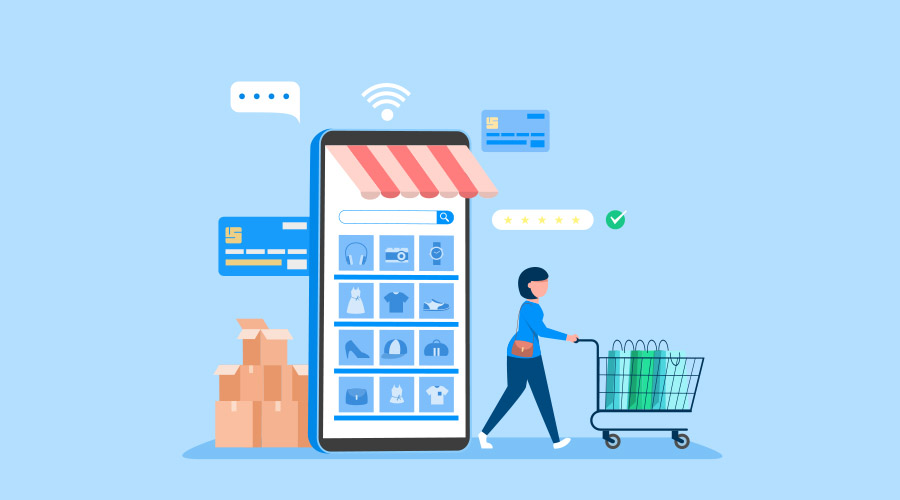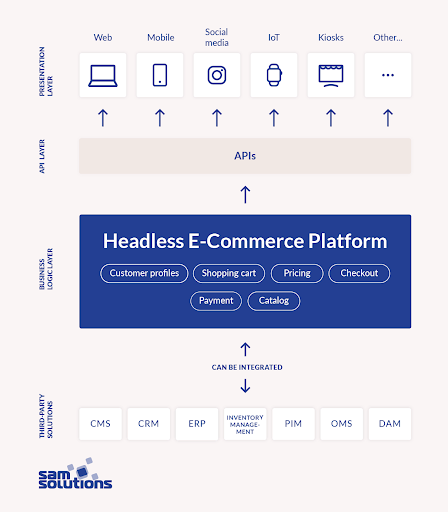7 Ecommerce Trends to Keep Up with in 2022

Ecommerce creates a level playing field for businesses dealing directly with customers. As an ecommerce business, you can provide an exceptional online experience to drive more business. But, success depends on how consistent you are with your services over time. This is why it is crucial to tap into various ecommerce trends, especially as moving towards 2022.
In This Post
According to eMarketer’s Insider Intelligence, US consumers are willing to spend more than $933 billion on ecommerce by the end of this year. This accounts for 15% of total retail sales with the expectation of hitting roughly 24% of all retail sales by 2025, a sizable portion of retail sales!
There are plenty of channels you can leverage to boost visibility and engagement for your ecommerce brand, from social media to email marketing and even message marketing on platforms like WhatsApp and Telegram. The pandemic-driven buying behavior pushed safety and convenience to become the top consumer priorities.
But with a failure rate of 80%, ecommerce companies need to frequently analyze the emerging trends in their industry and modify their strategy accordingly to stay afloat. Communicate your change in approach as you follow the new trends in 2022 by following these email marketing tips.
eCommerce Trends to Watch for in 2022
In a globally connected world, trends come and go but if you are engaged with the eCommerce business, you need to pay attention to some trends to deliver the right value to customers with the right tool. Let us check the top seven ecommerce trends that can help you stay updated in 2022.
1. Voice assistants
Many ecommerce businesses are already embracing the power of voice assistants. For instance, consider Yandex Alice that helps buyers make quick purchase items on the Yandex market.
Amazon is one of the most popular internet marketplaces in the United States and is accounted for a leading 37.3% of the online retail sales in the U.S. Around 10.8% of digital buyers used Amazon Alexa for online shopping last year. This is a growing trend in the United States, but it’s possible that by 2022, a greater number of people will opt for virtual assistants to make quick purchases.
For on-the-go buyers, voice shopping is synonymous with ease. The proportion of the smart-speaker market is expected to reach $17.85 billion in 2025 at a CAGR of 26%. And this is certainly a trend worth following!
Optimizing the platform for this trend requires optimizing the content and placing a premium on search volume. If possible, pivot efforts to create both the site and the smartphone version.
Another critical step is to verify that voice instructions are functioning correctly. Ensure conducting a comprehensive test to ensure that the end-user has no difficulty purchasing things that use the Voice Assistant.
Since voice searches do not employ pictures, voice purchases present a consumer hurdle. Because of this, buyers tend to adhere to more conventional things, such as food, low-cost gadgets, and homeware, that do not need many visual references.
2. Social media shopping
More than 3 billion people use social media every day, with almost 54% of them leveraging it to browse new products and decide purchases. This has given rise to social commerce. And businesses embrace social commerce to enable consumers to buy straight from social media platforms, negating the need for any separate marketplace or even a website (though it’s always advisable to have one).
Recently, Instagram too joined the bandwagon with its checkout feature, helping businesses connect meaningfully with potential sellers. Ultimately, if users want to browse products and buy items, they don’t need to leave social networking platforms.
3. Product customization
Product customization boosts customer satisfaction due to the purchase’s distinctiveness.
For instance, buying a pair of Nike’s Lunarglide enables you to customize your pair and choose your favorite colors. As more companies embrace this approach in time to come, you can start with this trend before your competitors. Customization simplifies the purchasing experience and boosts brand loyalty in the longer run.
4. Augmented Reality (AR)
Incorporating AR into your ecommerce shop offers you an unmatched advantage. It is estimated that 17% of consumers in the US will use AR monthly by 2022. Goldman Sachs estimates that the market for augmented and virtual reality in retail will reach $1.6 billion by 2025.
The same report states that two-thirds of internet users are enthusiastic about AR, and 63% believe that such technology would alter their shopping habits.
Such technology enables customers to picture better the goods they want to purchase, simulating the in-store experience.
Setting up an AR-based ecommerce store can give your business the edge over your competition. Start providing virtual shopping assistance in 2022, which will open the way to cater to most customers. Additionally, 71% of shoppers would spend more money in that store to interact with the items through this technology.
5. Headless ecommerce
Headless ecommerce leaves your front-end (head) of the store empty. Meaning there will be no theme or template for users to interact with. You may choose to have complete control over the front-end structure and plan to provide a more customized and seamless user experience.
However, you can use the pre-designed, bespoke front-end as all layouts on the market are created in line with the ecommerce platform’s design.
The front-end and back-end of a headless ecommerce platform are independent. This implies that a back-end modification need not follow any changes made to the front-end of your store appearance.

Image: (Source)
You can acquire the back-end data through API requests which are not accessible to the front-end. For your ecommerce business, this will mean having complete control over the UX/UI of your website across many channels (desktop, social media, mobile). You need to plan everything around your target audience and create a design that represents the brand.
The headless architecture of a well-known ecommerce architect enables more control over the content and a more seamless consumer experience until the checkout process. Indeed, it would help investigate headless integrations to capitalize on this trend fully.
It is recommended to opt for this ecommerce trends in 2022 because, as a store owner, you want to command your front-end design and website layout completely. However, ecommerce platforms are available in the market with a premade design where you can change themes and structure all other layouts as per the platform architecture.
6. Multichannel personalization
One of the best ways to leverage personalizing consumer interactions is to integrate into the selling process. Ecommerce businesses use more than one channel to create a sales funnel that ensures a comprehensive customer experience across all channels.
A lot would boil down to identifying your audience when opting for a multichannel personalization strategy. Since 72% of consumers engage with marketing messages tailored to their interests, channel-wide personalization is the key.
Each channel you use should be compatible with your overall ecommerce strategy, industry, and intended audience. For instance, you need to consider your audience before considering email or mobile marketing. Ask the question as to whether they prefer that you send them text messages or emails?
Moreover, focus your efforts on the most relevant channels to your target demographic. In terms of active users, no other social media platform comes close to rivaling Facebook’s global dominance, and it is a suitable platform for B2C ecommerce branding.
However, if you are a B2B ecommerce platform, you might have a hard time reaching your audience on platforms like Facebook and Instagram. Using LinkedIn and Twitter can prove to be a better bet in this situation.
7. Customized packaging
The trend of customized packaging is not new. But, its significance is bound to improve in time to come. We’ve observed a growing number of firms abandoning simple or stock packaging as a result of the exponential surge in internet buying. Boxes, meanwhile, have taken on a more artistic flair of their own as firms strive to convey a small bit of themselves to their consumers’ doorsteps via their packaging.
Many personalized beauty products are also using customers’ names on labels to ensure that the product is crafted exclusively for them. This is because many people are now using their Instagram and other social media channels to show their gifts and tag their friends who gifted them. This means, more people are becoming particular in their demands, forcing brands to level up their personalized packaging game.
The trend of customized packaging is not new. But, its significance is bound to improve in time to come. A growing number of ecommerce businesses are doing away with simple or stock packaging due to the exponential surge in internet buying.
Boxes, meanwhile, have taken on a more artistic flair of their own as firms strive to convey a small bit of themselves to their consumers’ doorsteps via their packaging.
Many personalized beauty products also use customers’ names on labels to ensure that the product is crafted exclusively for them. Many people are now using their Instagram and other social media channels to show their gifts and tag their friends who gifted them.
This means more people are becoming particular in their demands, forcing brands to level up their personalized packaging game.
For instance, there is a growing demand for environmentally-friendly packaging. And since 62% of consumers consider purchasing from a company that shares their values, this is a major consideration.
Due to changing customer demographics, sustainability, recycling, and environmental problems have gained prominence. Zero-waste packaging is increasing, as are other eco-friendly packaging materials. Natural components including mushrooms, sugar cane, cornstarch, and plant-based paper are growing popular.
Modern Technology Continue to Fuel eCommerce Trends
While many of the trends on our list are not wholly new, their continued fundamental relevance to the success of eCommerce suggests a massive room to develop in the coming year. These trends are already showing us how best eCommerce companies should function amidst growing competition.
Above mentioned eCommerce trends to watch in 2022 indicate that there are many scopes to grow by breaking the conventional patterns. Now is the right time to make changes, adopt newer technologies, and craft a strategy that transforms your business position in the world of online retailing.




